Programme
Programme Workshop - Expert Discussion on
Climate Change and its Impact on Hydrology and Water Management in the Rhine basin
24th June 2003
Registration and Lunch from 11.00 a.m.
13:00 Welcome by Prof. Dr. Manfred Spreafico - Preseident of the CHR
13:10 Introduction and Goals of the Workshops by Dipl.Met. Peter Krahe
Theme block I - Observed variability in climatological and hydrological data
Chairman: Dr. Laurent Pfister
13:30 European Climate Assessment project and possible role of the CHR - Albert Klein Tank, KNMI, De Bilt
14:00 Extreme hydrological events monitoring using Earth Observation data - Stephen Clandillon, Sertit, Strasbourg
14:30 Coffee / Tea break
15:00 Changes in the extreme discharge of the Meuse river over the past century - Tu Min, UNESCO-IHE, Delft
15:30 Streamflow trends in Switzerland - Paolo Burlando, IHW - ETH Zürich
16:00 CHR-Project: Developments in the flow regime of the river Rhine - Jörg Uwe Belz, BfG, Koblenz
16:30 Discussion on theme block I
17:00 Snacks and Refreshments
Theme block II - The creation and interpretation of climate scenarios
Chairman: Dr. Christoph Ritz
17:30 Regional climate modelling for the Rhine basin - Bart van den Hurk, KNMI, De Bilt
18:00 Coupled catchment-based meteorologic and hydrologic data reconstruction - why, how and what for - Emiel van Loon, Universität Wageningen
18:30 Discussion
19:30 Participants dinner near the conference centre
25th June 2003
Theme block II (continuation)
08:30 Impact of tropical and extratropical climate modes on the North Atlantic/European climate - Mojib Latif, IfM, University Kiel
09:00 Climate change and runoff from processes to scenarios - Christoph Schär, ETH Zürich
09:30 Precipitation distribution and its variability in the Elbe and Rhine drainage basins under current and future climate conditions - Daniela Jacob and Katharina Bülow, MPI, Hamburg
10:00 Coffee break
10:30 Precipitation frequency and intensity under global warming scenarios - Gerd Bürger, University Potsdam
11:00 Discussion on theme block II
Theme block III - Discharge regimes and hydrological extremes - What do the models predict?
Chairman: ir. Hendrik Buiteveld
11:30 Impact of climate change on floods and the runoff regime in Rhine basin - Erwin Zehe, IHE, University Stuttgart
12:00 Lunch
13:00 Impacts of climate change on flooding in the river Meuse - Martijn Booij, University Twente
13:30 Estimation of future flows of the river Rhine in the SWURVE project - Geert Lenderink, KNMI, De Bilt
14:00 Climate change and runoff statistics: a process study for the Rhine basin using a coupled climate-runoff-model - Jan Kleinn, ETH Zürich
14:30 Coffee / Tea break
15:00 Final discussion, summary and conclusions of the workshop
16:00 Closing of the workshop
| Bárdossy, András | Institute of Hydraulic Engineering, University Stuttgart |
| Beersma, Jules | KNMI, De Bilt |
| Bierkens, Marc | University Utrecht |
| Booij, Martijn | University Twente, Enschede |
| Bruin, Dick de | Rijkswaterstaat, Den Haag |
| Buiteveld, Hendrik | Rijkswaterstaat RIZA, Arnhem |
| Bülow, Katharina | Max Planck Institute for Meteorology, Hamburg |
| Bürger, Gerd | University Potsdam |
| Burlando, Paolo | IHW, ETH Zürich |
| Clandillon, Stephen | SERTIT, Strasbourg |
| Demuth, Siegfried | Federal Institute for Hydrology, Koblenz |
| Deursen, Willem van | Carthago Consultancy |
| Drogue, Gilles | Centre de Recherche Public - Gabriel Lippmann |
| Haasnoot, Marjolijn | WL | Delft Hydraulics, Delft |
| Hurk, Bart van den | KNMI, De Bilt |
| Jacob, Daniela | Max Planck Institute for Meteorology, Hamburg |
| Jacobs, Pieter | Rijkswaterstaat RIZA, Rotterdam |
| Kleinn, Jan | Institute for Atmospheric and Climate Science, ETH Zürich |
| Klein Tank, Albert | KNMI, De Bilt |
| Krahe, Peter | Federal Institute for Hydrology, Koblenz |
| Kromp-Kolb, Helga | Institute for Meteorology, BOKU, Vienna |
| Lammersen, Rita | Rijkswaterstaat RIZA, Arnhem |
| Latif, Mojib | IfM, University Kiel |
| Lenderink, Geert | KNMI, De Bilt |
| Loon, Emiel van | University Wageningen |
| Min, Tu | UNESCO IHE, Delft |
| Pfister, Laurent | Centre de Recherche Public - Gabriel Lippmann |
| Reggiani, Paolo | WL | Delft Hydraulics, Delft |
| Richter, Karl-Gerd | Dr. -Ing Karl Ludwig Ber. Ing. Wasserwirtschaft, Wasserbau |
| Ritz, Christoph | ProClim Forum for Climate and Global Change |
| Schär, Christoph | ETH Zürich |
| Spreafico, Manfred | Federal Office for Water and Geology, Bern |
| Sprokkereef, Eric | Secretariat CHR, Arnhem |
| Stegeman, Frouwke | Secretariat CHR, Lelystad |
| Tomson, Arike | Rijkswaterstaat RIZA, Lelystad |
| Torfs, Paul | University Wageningen |
| Ulden, Aad van | KNMI, De Bilt |
| Wilke, Klaus | Federal Institute for Hydrology, Koblenz |
| Wit, Marcel de | Rijkswaterstaat RIZA, Arnhem |
| Zehe, Erwin | Institute of Hydraulic Engineering, University Stuttgart |
| Zimmermann, Lothar | Bavarian Water Management Agency, Munich |
Introduction
Based on the results of the project 'The Impact of Climate Change on Hydrological Regimes and Water Resources in Europe', funded by the EU (1995-1997), a working group chaired by the International Commission for the Hydrology of the Rhine basin (CHR) proposed management strategies and policy implications with regard to the possible impact of climate change on hydrology and water resources management. The findings are published as the so called Nijmegener declaration 1997.
There has been a marked increase in recent years in the resources dedicated to investigating the problems arising from climate change with respect to hydrology and to some extent to water resources management, too. Many of these studies are concentrated on the basin of the River Rhine. Additionally, the extreme flood situations that have meanwhile occurred in the basins of the Danube, Rhine, and Elbe have brought foreward - in terms of both expert discussion and public debate - questions regarding causes, with particular reference to climatic matters. Apart from the effects of predicted climatic changes on meso scale (regional) river basins, changes in the discharge characteristics of major rivers are also of great interest.
In order to review the actual state-of-the-art, a workshop was held on June 24th and 25th 2003 in Ede (The Netherlands). The questions arising from these subjects were discussed by experts from several disciplines. The presentations and discussions were organised in three thematic blocks:
- Theme I: Observed variability in climatological and hydrological data
- Theme II: The creation and interpretation of climate scenarios
- Theme III: Discharge regimes and hydrological extremes - What do the models predict?
The event was addressing the scientists from research institutions and water management authorities, that deal with the above-mentioned problems. The expert discussion was designed to raise the current level of knowledge in terms of its specific connection to the Rhine basin. With the participation of researchers dealing with the same subject in neighbouring river basins - such as the Meuse, Danube and Elbe - the intention was to encourage an exchange of information regarding the methods being applied.
The workshop investigated the question of whether current knowledge and procedural strategies can be used as a basis for future water management. Knowledge deficits in this area were identified during the workshop sessions. Discussion outcomes resulted in recommendations for future research activities and homogenised working procedures with a view to find solutions to the above mentioned problems.
The steering committee of the workshop has summarised the findings and recommendations issued from the presentations given during the two-day event. Moreover, an evaluation of the results with regard to further actions in water resources management is given hereafter.
The global climate is changing
Global scale
The IPCC third assessment report 2001 gives the following key findings:
- There is new and stronger evidence that most of the warming observed over the last 50 years is attributable to human activities
- Global average temperature and sea level are projected to rise under all IPCC scenarios
- For the 21st century it is likely that
- higher maximum temperatures and more hot days over nearly all land areas will occur,
- there will be increased summer continental drying and associated risk of drought over most mid-latitude continental interiors and
- more intense precipitation events will occur. - After 2050 the model results start to indicate distinct climatic trends for the different scenarios, since they make critical assumptions on how humanity will cope with global change.
Regional scale
These findings are likely to have an impact on the hydrological regime on the Rhine basin scale.

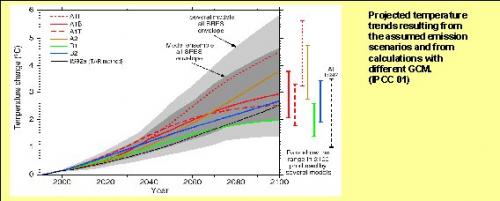
Evidence of changes in observed hydrometeorological variables and discharge in the Rhine basin
Theme block I - Observed variability in climatological and hydrological data
European Climate Assessment project and possible role of the CHR (Albert Klein Tank)
Extreme hydrological events monitoring using Earth Observation data (Stephen Clandillon)
Changes in the extreme discharge of the Meuse river over the past century (Tu Min)
Streamflow trends in Switzerland (Paolo Burlando)
CHR-project: Developments in the flow regime of the river Rhine (Jörg Uwe Belz)
For the interpretation of the spatial trend patterns the atmospheric circulation types as well as the orographic obstacles have to be considered.
Findings
Climate
- Spatial trend patterns of climatological variables are linked to atmospheric circulation types,
- Clear increase in winter precipitation,
- Increase of number of extreme wet days in winter (duration curves are altered),
- No clear trend in summer precipitation,
- Moderate increase of number of dry days in summer,
- The frequency of extreme precipitation events increases more than seasonal means,
- Increase of minimum temperature in winter, which reduces the snow cover and thus the winter runoff
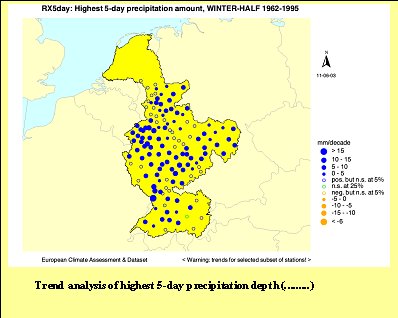
Discharge
Natural stream flow has definitely changed in the last decades
Increase in stream flow, mainly in winter (and spring), mainly for the low and mean flows. (presentation Burlando)
Changes in precipitation amounts cannot alone explain changes in stream flow. Climate variation overrules other basin characteristics at least for generation of floods (this applies as long as no water regulation measures are taken)
Runoff in mountainous areas is particularly reactive to climate change.

Recommendations
Assessment of man made and natural variability
Collect and homogenize long hydrological and hydrometeorological observation series, complemented by proxy data, in order to extend the series further back. Current field monitoring has to consider the spatial heterogeneity of the physiogeographical characteristics of river basins.
Data needs for the calibration and validation of hydrological and climatological models
Build well defined, problem oriented and consistent hydro meteorological data sets for the River Rhine (areal or raster based precipitation, potential evapo-transporation, soil moisture and ground water storage). This is an absolute prerequisite for an efficient calibration and validation of hydrological and climatological models.
Homogenisation of statistical trend analysis methods over the Rhine basin
Statistical analysis should be applied on different scales (continental, regional and local) and with agreed upon methods. This is necessary for the interpretation of the spatial variability of trends in climatological and hydrological time series.
The currently ongoing research efforts in the field of change detection in hydro-climatological time series has to take into account the above recommendations, so to provide the necessary database and knowledge for an efficient calibration and validation of hydro-climatological models. Once the very complex interactions between basin-related factors and hydro-climatological variables are correctly assessed, these models can be efficiently used for the creation and interpretation of climate scenarios.
Climate change: from global to the River Rhine basin
Theme block II - Creation and interpretation of climate scenarios
- Regional climate modelling for the Rhine basin (Bart van den Hurk)
- Coupled catchment-based meteorologic and hydrologic data reconstruction - why, how and what for (Emiel van Loon)
- Impact of tropical and extratropical climate modes on the North Atlantic/European climate (Mojib Latif)
- Climate change and runoff from processes to scenarios (Christoph Schär)
- Precipitation distribution and its variability in the Elbe and Rhine drainage basins under current and future climate conditions (Daniela Jacob and Katharina Bülow)
- Precipitation frequency and intensity under global warming scenarios (Gerd Bürger)
Findings
- Performance of both regional and global models have improved significantly during the past decade,
- Especially in winter the climate in central and northern Europe is modulated by the North Atlantic Oscillation (NAO). The NAO typically persists over several months. There are indications that the NAO is coupled with the surface temperature of the Indian ocean. With global warming there is a tendency towards a more positive NAO leading to an increased probability of very wet winters over northern Europe. Additionally, extreme rainfall events will become more likely over northern and central Europe.
- The sensitivity of the thermohaline circulation ("gulf stream") to climate change is still uncertain. A reduced thermohaline circulation, however, will have a strong impact on the European climate.
Global as well as regional climate models yield:
- consistent trends among different models,
- agree with the physical understanding of the climate system,
- show similar trends in temperature and (to a lesser degree) in precipitation.
Scenario runs show (based on most models validated in the EU-project PRUDENCE) :
- In winter an increased precipitation over the northern and central part of Europe.
- In summer a substantial reduction in mean precipitation and an increase of strong precipitation events
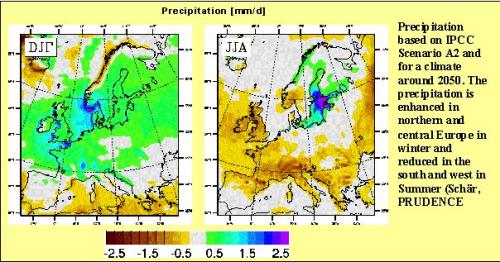
For the Rhine basin at least three regional numerical models and several statistical models exists. Climate scenarios are calculated with the REMO model. The other two models (KNMI RACMO and Swiss CHRM model) are in test mode.
For regional and local climate modeling it is sufficient to use a horizontal resolution of 0.16° (18 km) as grid cell (with the exception of regions with very complex topography).
The regional models have a tendency to underestimate high precipitation events in summer due to an underestimation of convective processes.
Additional uncertainties persist due to the important role of soil moisture and other land surface processes.
With decreasing size of the river basin the model results become less reliable.
Recommendations
- Model intercomparison should be performed using the same climatological and hydrological data to estimate the uncertainties and thus to improve confidence in the model results.
- As input parameters, calibrated hydrological data must be available far beyond the river basin under consideration
- The hydrological models must be tested on different river basins and should lead to universally applicable models.
- The hydrology should be better integrated into the climatological models.
- Both statistical and numerical models can be used for regional climate modelling. The statistical models should be used for uncertainty assessment.
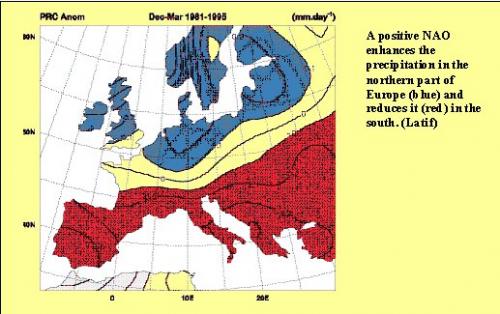
Will we have more floods and droughts?
Theme block II -Discharge regimes and hydrological extremes - What do the models predict?
- Impacts of climate change on flooding in the river Meuse (Martijn Booij)
- Estimation of future flows of the river Rhine in the SWURVE project (Geert Lenderink)
- Climate change and runoff statistics: a process study for the Rhine basin using a coupled climate-runoff-model (Jan Kleinn)
Findings
Discharge:
- Discharge of Rhine (and Meuse) will increase in the winter season due to climate change
- Results for the summer season are however more uncertain. A decrease is likely in the view of the predicted decreasing precipitation.
- Especially for extreme events, the uncertainty in climate driven discharge changes is larger than the trend itself.
Hydrological models:
- Improvement of model results is not similar to increased model complexity.
- There is a need for a better validation of the hydrological models, especially for extreme events (floods and droughts).
- Direct coupling of regional climate models with hydrological models is a step forward that is made during the last decade. For the present regional climate models however still substantial corrections are needed to represent climatology in a specific river basin.
- Probabilistic approaches are necessary for model interpretation. At the moment it is still unclear at which part of the modeling chain these should be implemented.
- Studies related to the vulnerability of water resource systems can be carried out.
Recommendations
- Further improvement of climate models is necessary.
- The terrestrial hydrological cycle should be implemented consistently in climate models.
- Ensemble calculations are necessary to define uncertainties.
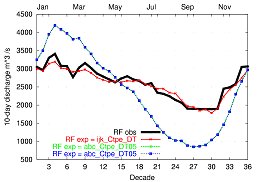
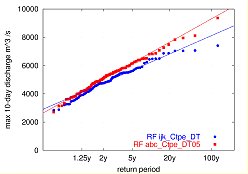
Sensitivity analysis of climate impact on discharge at gauge Lobith (Lenderink et al.)
Recommendations for water resources management strategies
Knowledge, or at least an estimation of climate change in the River Rhine basin in the past and in the future is a prerequisite for the development of water resources management strategies. For the historical period reliable measurements are available for the last 100 - 50 years. Analysing these data sets, clear trends can be detected. Although the scientific community is still discussing whether or not all the long term variation can be related to the well known anthropogenic influences, it becomes more and more obvious that the variability reaches such dimensions, that these have to be considered in future planning activities in view of necessary adaptation measures to the impacts of climate variability and change.
Although at present no founded quantitative information can be given yet about the influence of climate variability and change on discharge and groundwater recharge nor on the occurrence of hydrological extremes like floods and droughts, potential hazards can be derived from the information and scientific analysis that is presently available, which call for action from politics, economy and science and aiming at the preparation of mitigative measures for the protection against extreme events and adaptation to the consequences of climate variability and change . Considering the still increasing concentration of economic values especially in flood-prone areas, there is a necessity to create an environment of rational awareness of risks and vulnerability to extreme events and the need to plan and implement adequate structural and non-structural measures to protect the potentially affected population from possible disasters, taking into account our present knowledge on climate variability and climate change.
Being aware of climate change trends and processes and its potential hazards, preventive adaptation and mitigation objectives as well as accepted residual risks should be adapted periodically to the changing environment and scientific knowledge and solutions with maximum flexibility should be strived for. For the medium range period new methods for design and planning must be developed, that are capable to quantify hazards in a changing climate.
The principle of "No regret and flexibility" was a recommendation for an appropriate management response given by CHR in the so-called Nijmegen Declaration (1997). The results of the workshop underline this strategy. Long-term plans should be flexible and adaptable to a growing knowledge base and the dynamically changing hazard situation. Sustainability in an ecological, economical and social sense should be the guiding principle for planning and decision-making. Anticipatory measures, which serve different goals, should be undertaken in combination with on-going activities, e.g. sustainable flood protection measures. Not all of these measures can be justified with the objectives of flood protection alone but need to be undertaken from the viewpoint of a politically supported process of integrated flood management as a component of integrated water resources management taking into account anticipated effects of climate change.
With the presently available tools for regional climate modelling and coupled hydrological modelling in the Rhine basin, essential building blocks are provided to determine the sensitivity and adaptive capacity of hydrological systems under consideration of socio-economic components, locally as well as for the entire Rhine basin. The core problems must be identified and based on their identification, strategies to adequately address these problems need to be developed. For decision making in water resources planning the following steps should be taken into account:
- Development of probability density functions for potential impacts of floods (and drought) based on expected economic losses in affected areas.
- Disaster reduction effectiveness should be the guiding principle for the evaluation of modelling results.
- Studies related to the vulnerability of water resources systems should be carried out.
- Sophisticated methods have to be developed in order to deal with decision-making under uncertainty.
The demand for a uniform approach to the problem of climate change impacts in the entire Rhine basin asks for integrated thinking and acting on local, regional as well as national and international scale in the Rhine riparian states. Therefore, inputs from politically influenced subject areas such as spatial planning (including building codes, industrialization and infrastructure development), nature conservation, agriculture and forestry are absolutely necessary. Besides this, the challenge of decision making in an international river basin such as the River Rhine basin with regard to climate variability and change has to be outlined. This is due to the fact that adaptation and mitigation strategies should follow an integrated approach for the whole basin. This requires, as a first step a consensus of the awareness and assessment of the problem in the whole basin. Therefore, the communication and exchange of scientific findings between research groups and water management authorities focusing on a specific river basin becomes an important item in the decision making process. It can be stated that different acceptance levels of the quantitative results of climate impact research, as well as different strategies for transforming these results in water resources management actions can be observed. The outline of river-basin wide climate and hydrologic projections and their inherent uncertainties in prediction becomes an important part in decision-making with respect to climate change impacts.
